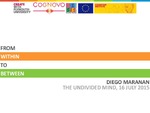From Within to Between
| dc.contributor.author | Maranan, DS | en |
| dc.date.accessioned | 2015-10-18T18:02:57Z | |
| dc.date.available | 2015-10-18T18:02:57Z | |
| dc.date.issued | 2015-10-16 | en |
| dc.identifier.uri | http://hdl.handle.net/10026.1/3661 | |
| dc.description | This presentation was prepared as part of the Marie Curie Initial Training Network FP7-PEOPLE-2013-ITN, CogNovo, grant number 604764. | en |
| dc.description.abstract |
Somaesthetics is an approach advanced by Richard Shusterman (2000, 2006, 2008) in which bodily experience plays the central role in aesthetic appreciation, production, and analysis. Somaesthetics draws from a variety of epistemological approaches, including the philosophies of twentieth-century thinkers such as as Merleau-Ponty (1962), de Beauvoir (1997), Foucault (1986), and Wittgenstein; pragmatist philosophies of William James and John Dewey; and theoretical and practice-based contributions of somatic practitioners such as Moshe Feldenkrais and Frederick Alexander. It is an ameliorative approach that encourages heightened awareness of the body leading to an improved “use of the self” (Shusterman, 2008, p. 8). As a practice-based method, somaesthetics emphasises the role that movement and touch play in cultivating knowledge of the lived experience of the body (the soma). A growing number of researchers and artists have been using somaesthetics as an organising principle for the design and evaluation of new tools and technologies (Levisohn, 2011; Schiphorst, 2009). In this presentation, I review the varieties of ways in somaesthetics have played a role in such approaches. I then describe my current research project in which I integrate theories and approaches from contemporary cognitive neuroscience and experimental psychology as a somatic practitioner, in order to develop new frameworks for somaesthetic practice and theory. Focusing on themes of muscular tension, range of motion, and quality of movement within these frameworks, I describe how I intend to apply these themes to design and deploy instructional tools for online and distance education learners based in the Philippines, in order to empower them to explore somaesthetic principles within the context of their own lived and culturally-inflected experience. I conclude by arguing the relevance of my work, which I see as the foundation for a much larger goal—that of situating somaesethetics within social and political activity in the increasingly digitised, networked global South. | en |
| dc.language.iso | en | en |
| dc.title | From Within to Between | en |
| dc.type | Conference Contribution | |
| plymouth.date-start | 2015-10-16 | en |
| plymouth.date-finish | 2015-10-17 | en |
| plymouth.date-finish | 2015-10-17 | en |
| plymouth.publication-status | Unpublished | en |
| plymouth.organisational-group | /Plymouth | |
| plymouth.organisational-group | /Plymouth/Faculty of Arts, Humanities and Business | |
| plymouth.organisational-group | /Plymouth/Faculty of Arts, Humanities and Business/School of Art, Design and Architecture | |
| dc.publisher.place | Plymouth University, UK | en |
| dc.rights.embargoperiod | Not known | en |
| rioxxterms.licenseref.uri | http://www.rioxx.net/licenses/all-rights-reserved | en |
| rioxxterms.type | Conference Paper/Proceeding/Abstract | en |


